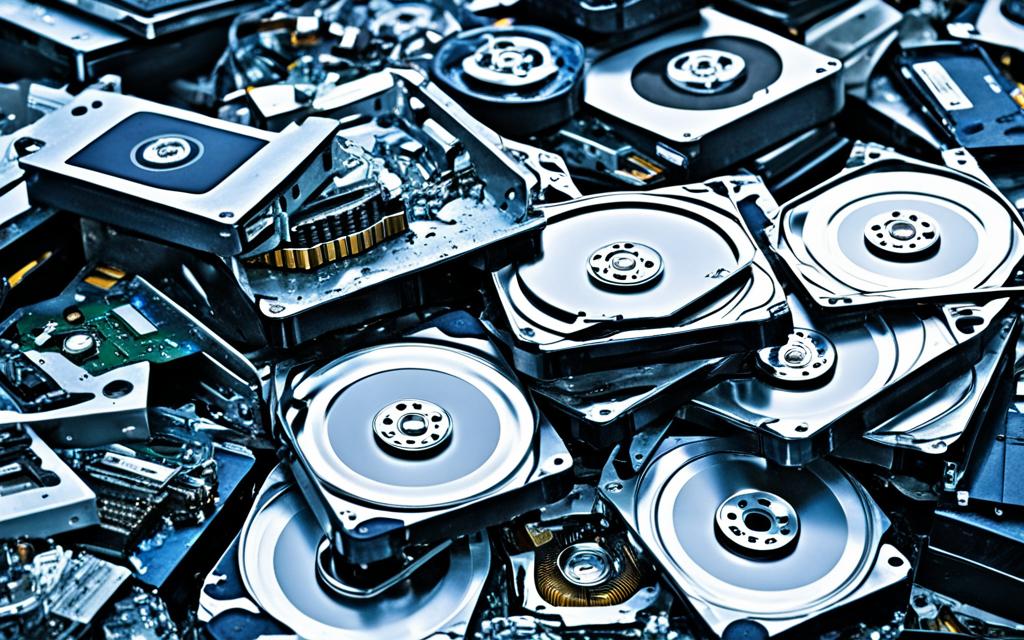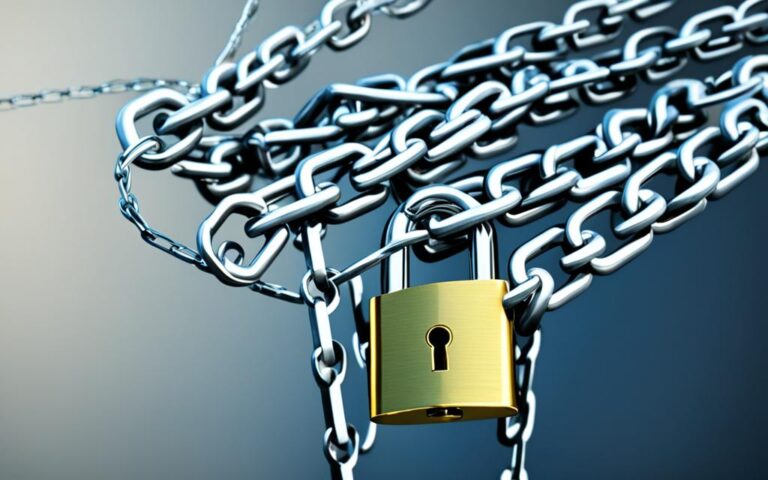Methods for Effective Physical Data Destruction
Data destruction is crucial for businesses to protect sensitive information from falling into the wrong hands. There are various methods available to effectively destroy data, ensuring that it is irretrievable. These methods include data deletion, wiping, overwriting, erasing, degaussing, physical destruction, and shredding. Each method has its pros and cons, and the choice depends on factors such as time, cost, validation and certification, and data destruction regulations.
Proper data destruction helps organizations prevent data breaches, secure data disposal, and adhere to data protection regulations. In this article, we will delve deeper into the different data destruction methods, their benefits, and considerations for effective data destruction.
What is Data Destruction?
Data destruction refers to the process of making data completely irretrievable on electronic devices. Simply deleting a file or reformatting a disk does not permanently erase the data. Data destruction methods involve overwriting the existing data with random or set patterns of ones and zeroes, physically destroying the electronic medium, or using powerful magnets to disrupt the magnetic structure of the storage media. The goal is to ensure that the data cannot be recovered by unauthorized individuals.
Why Data Destruction Matters
Data destruction is of utmost importance for businesses as it plays a vital role in safeguarding sensitive information and preventing data breaches. In today’s digital age, where companies heavily rely on electronic media, securely disposing of data at the end of its life cycle is essential to avoid potential risks and vulnerabilities. Failure to properly destroy data can result in severe consequences, including legal liabilities, reputation damage, and significant financial penalties.
Studies have shown that even after individuals or organizations attempt to delete data, many devices still retain residual information that can be recovered by unauthorized entities. Therefore, effective data destruction is crucial to protect confidential data from falling into the wrong hands and prevent unauthorized access.
By implementing secure data disposal practices, businesses can mitigate the risks associated with data breaches and ensure compliance with relevant regulations. Proper data destruction not only safeguards sensitive information but also provides peace of mind to organizations, employees, and customers.
It is important for businesses to invest in reliable data destruction methods and protocols that adhere to industry standards. These methods may include physical destruction, secure data wiping, degaussing, or shredding, depending on the nature of the data and storage media.
“Data destruction is not just about getting rid of old storage devices, but rather a comprehensive process that guarantees the irretrievable removal of sensitive information. It’s a critical step in the data lifecycle management, ensuring the confidentiality and integrity of data.”
To illustrate the importance of data destruction, let’s consider the case of a healthcare organization that stores patient records. If these records are not securely destroyed after their retention period, they can be accessed by unauthorized individuals, leading to privacy breaches and potential identity theft. This can not only harm the reputation of the organization but also compromise the safety and well-being of the patients involved.
Implementing secure data disposal practices not only protects businesses from legal and financial repercussions but also demonstrates their commitment to data privacy and security. It builds trust among stakeholders and strengthens the overall cybersecurity posture of the organization.
By prioritizing data destruction and secure data disposal, businesses can mitigate the risks associated with data breaches, protect their sensitive information, and ensure compliance with data protection regulations. Safeguarding data throughout its lifecycle, from creation to destruction, is a fundamental aspect of responsible data management and plays a crucial role in maintaining the integrity and confidentiality of information.
Data Destruction Types
There are various types of data destruction methods available to ensure the secure disposal of sensitive information. Understanding these methods is essential for organizations seeking effective data protection. The following data destruction methods offer different approaches to ensure data irretrievability:
Data Deletion
Data deletion involves removing files from the file folder, but it does not permanently erase the data. This method is not sufficient for sensitive information disposal and can leave traces that can be recovered by unauthorized individuals.
Wiping
To prevent data recovery, wiping involves overwriting the existing data on the electronic medium. By overwriting the data with random or set patterns of ones and zeroes, wiping ensures that the original data cannot be retrieved.
Overwriting
Overwriting data with random or predetermined patterns is a common and effective method for data destruction. By completely replacing the original data, overwriting renders it irretrievable.
Erasing
Secure erase protocols can be used to securely delete data from hard drives and solid-state drives. These protocols ensure that the data is overwritten and cannot be recovered, even through advanced data recovery techniques.
Degaussing
Degaussing is a method that uses powerful magnets to disrupt the magnetic structure of the storage media. By doing so, it renders the data on the magnetic medium unreadable and irretrievable.
Physical Destruction
Physical destruction methods involve the complete destruction of the storage media. Shredding and crushing are popular physical destruction techniques that reduce the media into tiny pieces. Incineration is an extreme method used for destroying certain types of storage media.
Each data destruction method offers different levels of security and suitability based on specific requirements. Understanding the strengths and limitations of each method is crucial for organizations to choose the most appropriate data destruction solution for their needs.
Logical Methods of Data Destruction
Logical methods of data destruction play a crucial role in rendering sensitive information unreadable on electronic devices. These methods utilize software to ensure the irrecoverability of data. Let’s explore some of the most commonly used logical data destruction methods:
1. File Wiping
File wiping involves overwriting files with random data multiple times, making it extremely difficult or impossible to retrieve the original data. By repeatedly writing new data over the existing files, file wiping ensures that no trace of the original information remains. File wiping is a reliable and efficient method to protect sensitive data from unauthorized access and potential data breaches.
2. Disk Formatting
Disk formatting is another logical data destruction method that erases all data on a storage device by reinitializing its file system. This process prepares the disk for reuse by removing all file references and making the data inaccessible. However, it’s important to note that disk formatting may not completely erase the data, as certain recovery techniques can still retrieve fragments of the original information.
3. Secure Erase Protocols
Secure erase protocols are specifically designed for solid-state drives (SSDs) and ensure the complete destruction of data. These protocols use advanced algorithms to overwrite the data on SSDs multiple times, effectively eliminating any possibility of recovery. Secure erase protocols provide an added layer of security for organizations, ensuring that sensitive data cannot be compromised.
4. Encryption-Based Destruction
Encryption-based destruction is a sophisticated method that encrypts the entire disk and then destroys or deletes the encryption key. Without the encryption key, the data becomes inaccessible and effectively useless. Encryption-based destruction offers a strong defense against data breaches and unauthorized access, as even if the storage media falls into the wrong hands, the encrypted data remains protected.
5. Data Erasure Software
Data erasure software provides a comprehensive solution for securely removing data from electronic devices. These software applications overwrite the data on the device multiple times, ensuring its irretrievability. Data erasure software allows organizations to efficiently and cost-effectively destroy data while adhering to compliance requirements and privacy regulations.
While logical methods of data destruction offer convenience and cost-effectiveness, it’s important to note that they may not provide complete assurance against sophisticated recovery techniques. In some situations, a combination of logical and physical data destruction methods may be the most appropriate approach to ensure the complete and secure destruction of sensitive information.
Hardware-Based Data Destruction Devices
When it comes to securely and efficiently destroying data, hardware-based data destruction devices are an excellent choice. These devices offer advanced techniques to ensure that no traces of data are left behind. Let’s explore three key hardware-based data destruction devices: degaussers, shredders, and disintegrators.
Degaussers
Degaussers are powerful devices that use magnets to disrupt the magnetic fields on hard drives and tapes. By doing so, they render the data on these media completely unreadable and irretrievable. Degaussing is an effective method to ensure that sensitive information cannot be recovered. It provides an extra layer of security for organizations dealing with highly confidential data.
Shredders
Shredders are physical destruction devices that physically destroy the storage media by cutting it into small pieces. This method effectively prevents any possibility of data recovery as the shredded pieces are no longer recognizable or usable. Shredders are commonly used for destroying hard drives, SSDs, optical media, and other electronic storage devices.
Disintegrators
Disintegrators employ high-speed blades or grinding mechanisms to reduce storage media into fine particles. This method ensures complete data destruction as the media is reduced to an unrecognizable state. Disintegrators are commonly used for destroying hard drives, tapes, CDs, and other similar media. They provide a high level of security and are ideal for organizations that require thorough data destruction.
When choosing a hardware-based data destruction device, several factors need to be considered. Organizations should evaluate their volume requirements, compliance regulations, and budget constraints to select the most suitable device for their needs.
Conclusion
Selecting the right method for data destruction is crucial for organizations to safeguard sensitive information and maintain compliance with regulations. When choosing a data destruction method, factors such as the sensitivity of the data, compliance requirements, volume of data, budget, and time constraints should be carefully evaluated.
Physical methods, such as shredding and crushing, offer reliability and effectiveness in securely disposing of data. However, it is important to consider the potential generation of electronic waste associated with these methods.
Logical methods, such as overwriting and encryption, provide convenience and cost-effectiveness. However, they may not always guarantee complete data removal, leaving a potential risk of unauthorized access to sensitive information.
Data erasure software and hardware-based devices offer versatile and secure solutions for data destruction, tailored to the specific needs of an organization. These options allow for efficient and effective data disposal, ensuring the safeguarding of sensitive information.
FAQ
What are the methods for effective physical data destruction?
The methods for effective physical data destruction include shredding, crushing, degaussing, and incineration.
What is data destruction?
Data destruction refers to the process of making data completely irretrievable on electronic devices to ensure it cannot be recovered by unauthorized individuals.
Why does data destruction matter?
Data destruction matters because it safeguards sensitive information, prevents data breaches, and protects against legal consequences, reputation damage, and financial penalties.
What are the different types of data destruction methods?
The different types of data destruction methods include data deletion, wiping, overwriting, erasing, degaussing, physical destruction, and shredding.
What are the logical methods of data destruction?
Logical methods of data destruction include file wiping, disk formatting, encryption-based destruction, and data erasure software.
What are hardware-based data destruction devices?
Hardware-based data destruction devices include degaussers, shredders, and disintegrators, which ensure that no traces of data are left behind on the storage media.
What is the importance of secure data disposal?
Secure data disposal is important for safeguarding sensitive information, maintaining compliance with regulations, and preventing unauthorized access to confidential data.













